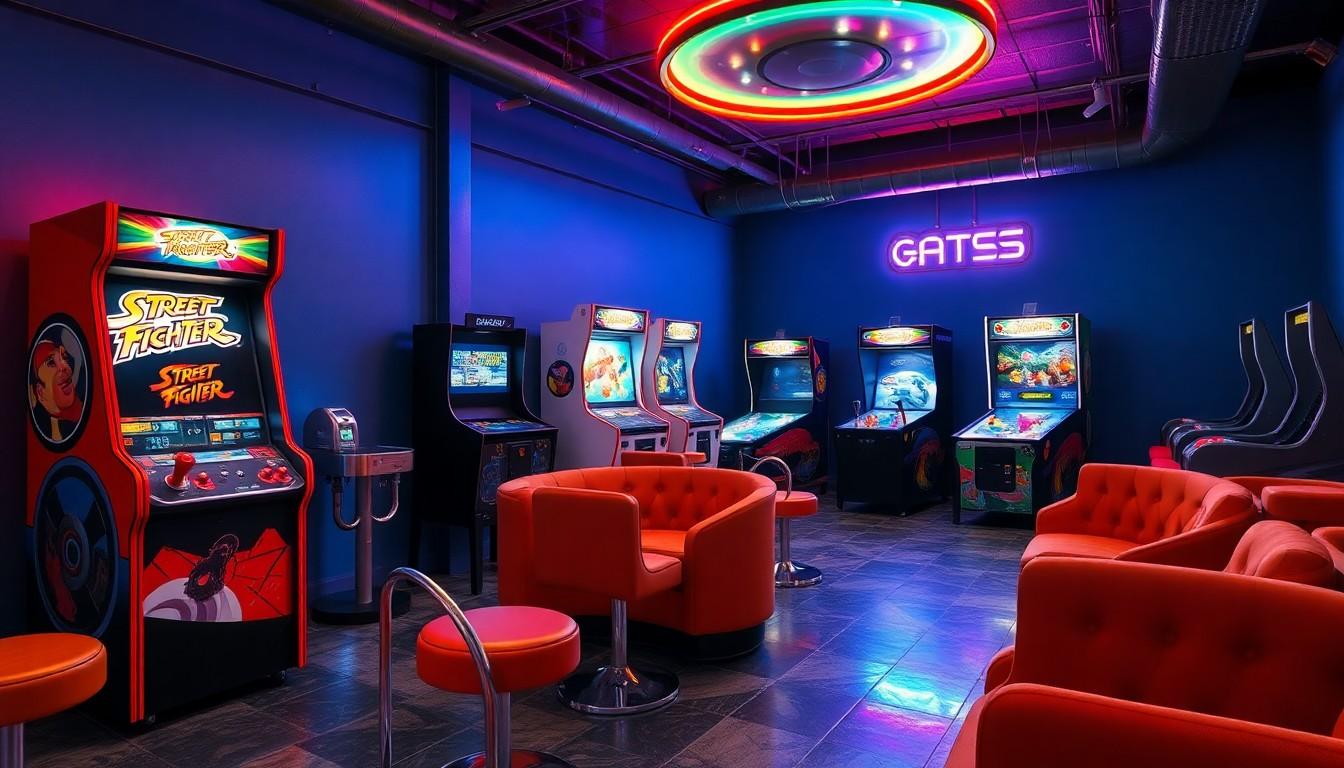Imagine stepping into a world where nostalgia meets modern gaming bliss. An arcade setup isn’t just about flashy lights and retro sounds; it’s about creating a haven for fun, competition, and a dash of friendly rivalry. Whether it’s reliving the glory days of Pac-Man or showcasing the latest in gaming technology, the right setup can transform any space into a thrilling playground.
Arcade Setup
Creating an arcade setup requires careful planning and consideration. A successful design integrates classic and modern gaming elements that appeal to various preferences. Layout plays a critical role; positioning games in a way that encourages interaction can enhance the experience. Combining different types of games, such as retro machines and modern consoles, attracts a diverse crowd.
Selecting the right equipment forms the backbone of the arcade. Essential components include gaming machines, seating options, and effective lighting. Machines from iconic titles, like Space Invaders or Street Fighter, often draw nostalgic fans. Seating arrangements should ensure comfort during extended gaming sessions without sacrificing available space.
Gaming area aesthetics enhance the overall atmosphere. Eye-catching signage initially captures attention and adds to the nostalgia factor. Additionally, theming can create an immersive environment, blending colors and designs that reflect gaming history.
Technology integration contributes significantly to the arcade setup. High-quality sound systems heighten the gaming experience and evoke familiar sounds from classic games. Installing reliable networking equipment enables seamless online gameplay, especially for multiplayer titles.
Safety considerations also hold importance in any arcade environment. Ensuring proper spacing between machines can prevent overcrowding and maintain an accessible flow for visitors. Regular maintenance of equipment guarantees a safe and enjoyable experience for everyone.
Ultimately, the objective of a well-designed arcade setup is to foster connections. He or she who creates an inviting atmosphere encourages friendly competition and community interaction. Balancing nostalgia with modern advancements transforms any space into a vibrant entertainment hub.
Essential Components of an Arcade Setup

Creating a successful arcade setup requires careful selection of essential components. This section highlights key elements to include in an arcade to ensure an engaging experience.
Arcade Machine Types
Classic arcade machines capture nostalgia while offering modern updates. Traditional pinball machines available create an exciting, hands-on gaming experience. Retro cabinets with iconic games like Space Invaders or Street Fighter attract enthusiasts. Newer machines often feature updated graphics and online connectivity, appealing to a younger audience. Racing simulators provide immersive gameplay through motion-sensing technology and realistic steering wheels. Multi-game cabinets present diverse options, allowing users to switch between various titles seamlessly. Each machine type contributes uniquely to an arcade’s environment.
Necessary Equipment
Comfortable seating serves as a foundation for social interaction among players. Arcade stools or lounge chairs enhance comfort during gaming sessions. High-quality sound systems elevate the gaming experience, immersing players in sound effects and music. Reliable networking equipment ensures smooth online play for multiplayer games. LED lighting sets the mood, enhancing visuals and creating an inviting atmosphere. Games requiring movement benefit from spacious layouts, preventing congestion near the machines. Proper maintenance tools help keep machines in top shape for an enjoyable experience. Prioritizing these equipment choices creates a vibrant arcade environment.
Space Planning for Arcade Setup
Creating an inviting arcade setup requires thoughtful space planning. Consider the available area and aim for a design that enhances the gaming experience.
Optimal Room Size
Optimal room size depends on the number of games and players. A space measuring at least 100 square feet accommodates two to four arcade machines comfortably. Larger setups benefit from 200 to 300 square feet, allowing for additional equipment and social spaces. Ventilation must factor in too; avoid overcrowding to ensure a comfortable environment. Feel free to adapt based on your gaming choices and target audience.
Layout Ideas
Layout plays a critical role in player interaction. Arranging machines in clusters promotes socialization while allowing players to easily move between games. Create zones, like dedicated areas for classic versus modern gaming, to cater to diverse preferences. Position seating around gameplay areas for a community feel. Ensure pathways are clear and accessible for safety and convenience. Eye-catching decorations complement the theme, luring players to engage with the arcade experience.
DIY Arcade Setup Tips
Creating a personal arcade setup can be a rewarding experience. It allows anyone to enjoy classic and modern gaming in the comfort of home.
Building Your Own Arcade Cabinet
Crafting an arcade cabinet requires careful planning. Start with choosing the right materials, such as plywood for durability. Measure dimensions based on available space to ensure proper fit. Next, consider a design that facilitates easy access to game controls. Select a screen size that balances visibility and space. Use a quality joystick and buttons for responsive gameplay. Assembly involves securing components firmly to eliminate wobbling during use. Finally, paint or decorate for a personalized touch, reflecting favorite games or themes.
Software and Games Selection
Select software that covers a variety of gaming styles. Emulators for consoles like NES and Sega Genesis allow users to experience classic titles. Ensure compatibility with the chosen hardware for smooth performance. Consider using platforms that offer a wide range of games, which may enhance replay value. Popular choices include MAME for arcade titles and RetroArch for console games. Keep in mind the licensing of games to avoid legal issues. Regularly updating software ensures access to new features and security improvements.
Maintenance and Upkeep
Regular maintenance is essential for ensuring an arcade setup remains functional and enjoyable. Scheduling periodic inspections allows for the identification of wear and tear on machines. Cleaning surfaces and screens helps maintain a visually appealing environment and extends equipment longevity.
Lubricating mechanical parts prevents unnecessary friction, which can lead to breakdowns. Testing all connections for sound systems and networking equipment guarantees optimal performance during gameplay. Inspecting wiring every few months reduces the risk of electrical issues that could pose safety concerns.
Replacing worn-out components, such as joysticks or buttons, keeps gaming experiences smooth and engaging. Establishing a cleaning checklist ensures all areas, including seating and decorations, remain tidy and inviting. Keeping spare parts on hand eliminates delays in repairs, allowing for faster turnaround times when machines malfunction.
Creating a log for maintenance records helps track machine performance and service history. This log proves useful for identifying patterns in breakdowns or issues, providing insight on when machines may require deeper attention. Consistent upkeep fosters a safe gaming environment, encouraging players to return for more fun.
Additional resources such as online forums and manufacturer manuals offer guidance on specific machine repairs and upkeep best practices. Emphasizing the importance of routine maintenance not only enhances the overall arcade atmosphere but also nurtures a loyal community of gamers eager to return to a well-kept space.
Creating an engaging arcade setup is a rewarding endeavor that merges nostalgia with modern gaming. By thoughtfully blending classic and contemporary elements he or she can craft an environment that fosters community and competition.
Attention to detail is vital from layout design to equipment selection. Prioritizing player interaction and comfort enhances the overall experience. Regular maintenance ensures that machines remain in top shape while a vibrant atmosphere invites both seasoned gamers and newcomers alike.
Ultimately a well-planned arcade setup serves as a hub for enjoyment and connection. It’s not just about the games but about creating lasting memories and building a loyal community.

